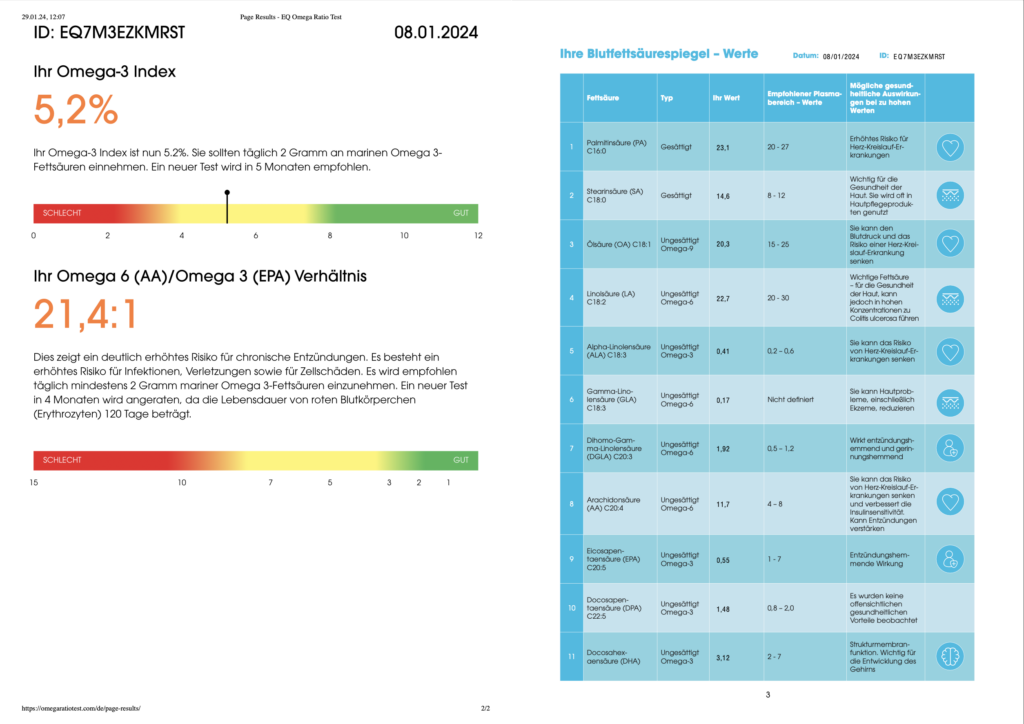Having already spent some time researching the topic of nutrients and fats in particular, I happened to have the opportunity to attend a training course on omega-3 and not only conduct an interview with a trained specialist, but also carry out a self-test.
During the interview, I learned about the most important aspects of omega-3 and its interaction with its counterpart omega-6, the most relevant fatty acids and how the tests are evaluated. I also learn that most Austrians today have a huge omega-3 deficiency. However, this is not because we eat less fish than we did a few decades ago, as one might initially assume. Instead, researchers believe the reason is that we are eating far more pro-inflammatory foods, such as convenience foods.
But why is this so important? Quite simply, as we all remember from our school days, every organ, every hair, every fiber of our body consists of individual cells that have joined together to form cell clusters with different tasks in order to perform certain functions. For example, our cells in the „skin“ cell group have the task of protecting us from external influences, absorbing substances from the environment and releasing others from the body into the environment. However, this exchange of substances can only take place in a fully functional manner if the cell membrane surrounding the cell is soft and permeable. This is exactly where our polyunsaturated fatty acid omega-3 comes into play. It helps to ensure that the cell membrane remains capable of absorbing and releasing nutrients. Only if we have enough omega-3 in our body can our cells carry out the important metabolic activities for which they are responsible.
If we have too few omega-3 and omega-6 fatty acids, our cells dry out and become wrinkled.The nutrients that are important for our body then simply bounce off the wrinkled cell membrane and the risk of possible deficiency diseases increases significantly.
These hardened cell membranes become dangerous when the body can hardly absorb vital micro- and macronutrients, but also when the substances stored in the cell can no longer be released properly. In the long term, this leads to inflammation.

This is not only relevant for the absorption of nutrients through the skin and food, it is also particularly important to ensure a sufficient omega-3 intake, as our brain consists of 60-70% fat.Of this fat, 90% is omega 3, so the link between optimal brain performance and a well-balanced omega 3 intake is obvious.
Apart from this, there is a whole range of diseases for which omega-3 is said to have a positive influence:
- Allergies
- Anti-ageing
- Arteriosclerosis
- Arthrosis
- Asthma in infancy
- Before/during pregnancy
- Burn out
- Cancer
- Cardiovascular
- Chronic fatigue syndrome (CFS)
- Coping better with stress
- Dental health
- Depression
- Diabetes
- Eczema
- Epilepsy
- Fasciae
- For fidgets (ADS + ADHD)
- Intestinal problems
- Lowering blood pressure
- Lowering triglycerides
- Mood swings
- Multiple sclerosis (MS)
- Musculoskeletal system
- Nerve food for the brain
- Neurodermatitis
- Omega-3 and sport
- Osteoporosis
- Panic attacks
- Parkinson’s disease
- PMS (premenstrual symptoms)
- Psoriasis
- Relieving migraines/headaches
- Rheumatism
- Sleep better again
- Strengthening eyesight
If we take a closer look at omega-3, it is made up of three different fatty acids:
- DHA – DOCOSAHEXAENOIC ACID
- Structure, including 25% of the nervous system
- Cognitive development
- Function visual development
- Inflammatory function
- Cardiovascular function
- EPA – EICOSAPENTAENOIC ACID
- Natural aspirin against
- pain/inflammation
- Cardiovascular function
- ALA – ALPHA-LINOLENIC ACID
- Plant-based omega 3 FS
- Linseed oil, hemp oil, chia seeds
- Only 0.5 – 5% DHA / EPA
- Energy source
The Context between Omega-3 and Omega-6
It is also important to understand the connection between omega-3 and omega-6 fatty acids. Omega-6 fatty acids recognize wounds and start the inflammation process, which is crucial for healing and is then stopped again by omega-3 fatty acids. Both fatty acids are therefore needed in the body in equal amounts. If we have an excess of one of the two fatty acids, the healing process cannot proceed undisturbed.
Omega-6 is often found as a preservative in ready-made products, but also in sunflower oil, gluten and wheat. It is also frequently contained in medicines, which is why we often find it in meat from factory farming. Furthermore, unhealthy lifestyles and habits, such as lack of exercise, stress, but also alcohol consumption and smoking, promote inflammation-promoting processes in the body.
My Self Test
For my self-test, I was pricked in a fingertip with a fine needle, similar to the blood sugar test, so that two drops of blood could be transferred to the test strip. This test strip was then sent to a laboratory in Norway together with my test ID created for this purpose. A few weeks later, I can look at my result and talk to the expert again.

Based on the two PDF files below, which I was able to download together with the results from the EQology website, this means for me that with an omega-3 index of 5.2% I am actually not that badly supplied with omega-3, even if not yet optimally. However, according to the expert, the ratio between omega-6 and omega-3 is dangerous for me. This should be a ratio of 1:1, but my omega-6 index is around 21 times higher than it should be.
If we take a closer look at the table on the right, we can easily find out why this is the case. Arachidonic acid in particular seems to be problematic for me, which can simply be traced back to my daily egg breakfast and the many dairy products in my diet.
My consultation with the expert lasts almost an hour. She recommends that I take an omega-3 oil supplement every day and then repeat the test in a few months to check whether my values have already improved.